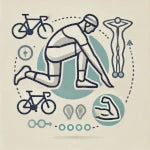
Flexibility and stretching exercises are often underestimated in cycling, but are crucial for improved performance, a lower risk of injury and more riding comfort. Especially in road cycling, where the muscles are often forced into a static, tense position, regular stretching exercises can contribute to greater mobility and better posture in the long term.
1. Why is flexibility so important for cyclists?
Cycling places a lot of strain on certain muscle groups - particularly the thighs, calves and hip flexors. The repetitive movements and static positions on the bike can cause these muscles to shorten and tighten. A lack of flexibility can then not only reduce performance, but also limit range of motion and lead to muscle tension.
2. Benefits of stretching exercises for cyclists
- Improved performance : Increased flexibility allows for more efficient movements. A smoother movement allows for better power transfer to the pedal, resulting in a more efficient ride.
- Lower risk of injury : Muscle shortening and tension can lead to overload, which increases the risk of strains and other injuries. Regular stretching counteracts these shortenings.
- Reduced muscle fatigue : More flexible muscles distribute the load better. This improves endurance and reduces fatigue during long rides.
- Increased freedom of movement : With flexible hips and relaxed shoulders, a comfortable and aerodynamic sitting position is easier to maintain.
3. The best stretching exercises for cyclists
-
Hip flexor stretch : When cycling, the hip is strongly bent, which often shortens the hip flexor muscles. A simple exercise is the lunge. To do this, place one leg forward and stretch the back leg as far as possible. Hold this position for about 30 seconds and then switch sides.
-
Hamstring and quadriceps stretch : The quadriceps are one of the most active muscles when cycling. To stretch this muscle, stand with one foot pulled back toward your buttocks and hold it with your hand. Make sure your knee stays parallel to your standing leg. Hold the position for 20-30 seconds, then switch legs.
-
Hamstring stretch (back of the thigh) : A shortened back of the thigh can lead to back pain and limit the pedaling motion. To do this stretch, sit on the floor, extend one leg forward and slowly bend forward with a straight back. Hold this position for 20-30 seconds.
-
Stretching the calf muscles : Since the calf muscles are used with every step, stretching them is important. Stand with one foot forward and support yourself with your hands on a wall. The back leg remains straight while you press the heel to the ground. Hold the position for 20-30 seconds and then switch legs.
-
Back and shoulder stretch : Spending long periods of time in a bent-over position on the bike can cause tension in the back and shoulders. For a simple stretch, lie on your back, pull your knees to your chest and hug them. Hold this position for a few seconds. Stretching the chest muscles, for example by stretching your arms against a wall, also helps with tension in the shoulder area.
4. When and how often should cyclists stretch?
For optimal results, we recommend incorporating stretching exercises into your training program after every ride. After a ride, the muscles are well warmed up and blood circulation is increased, which makes stretching particularly effective. A regular, short stretching program on rest days or after a warm-up can also increase flexibility and improve general mobility in the long term.
5. Dynamic and static stretching: what is the difference?
-
Dynamic stretching : This involves stretching movements in a flowing sequence, which is ideal for warming up before a ride. Dynamic stretching increases mobility and prepares the muscles for the strain.
-
Static stretching : After the ride, static stretching is advisable, where the stretching position is held for 20 to 30 seconds. It helps to relax the muscles and increase flexibility in the long term.
Conclusion: Flexibility as the key to performance
Stretching is an important part of a comprehensive training program that promotes both performance and well-being in cyclists. Regular stretching keeps muscles supple, increases range of motion and protects against injury. Whether on short training rides or long marathons, flexibility and stretching form the basis for a sustainable and high-performance cycling career.
At CYCLZ we not only support you with high-quality equipment, but also with tips that will best promote your body and your performance.
